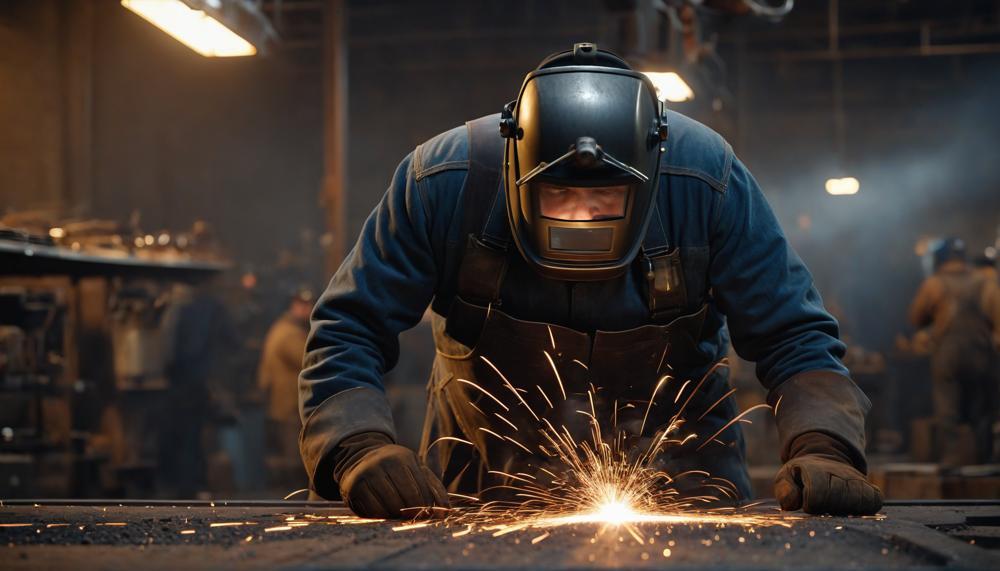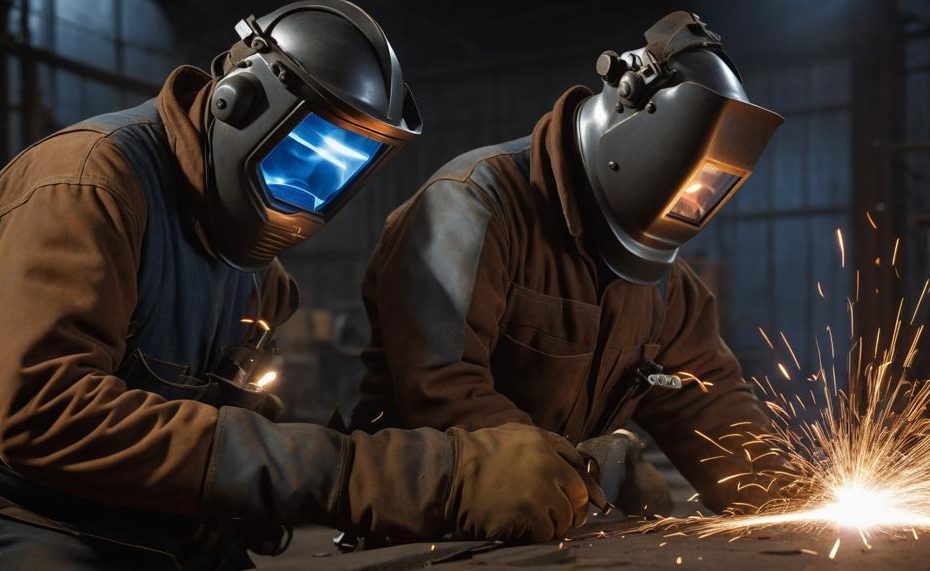Imagine stepping out into the world only to find that the very act of seeing, something we often take for granted, has become a painful ordeal. This isn’t the plot of a dystopian novel but a reality for many who experience the phenomenon known as welder’s flash or arc eye. This condition, striking swiftly and unexpectedly, mirrors the sudden and intense flare of a welder’s torch it’s named after. It serves as a stark reminder of the fragile balance between our technological endeavors and our physical well-being.
In this blog post, we’re diving deep into the world of welder’s flash, peeling back the layers to understand not just its immediate impact but its lasting effects. Here’s what you can expect:
- A clear explanation of what welder’s flash is, including its causes and symptoms.
- Insights into the duration of welder’s flash, with a focus on how long sufferers can expect to endure its effects.
- Preventative measures to avoid the condition, because knowledge is not just power—it’s protection.
- First-aid measures for those already affected, offering a beacon of hope and relief.
Join us as we explore this intersection of industry and health, shedding light on a condition that affects thousands each year. Whether you’re a professional welder, a curious bystander, or someone concerned about eye health, this post promises to illuminate, educate, and engage from start to finish.
Contents
What is a Welders Flash Burn?
A Welder’s Flash Burn, often termed as Arc Eye, is a painful eye condition primarily induced by exposure to the intense ultraviolet (UV) rays emitted from welding torches and similar sources.
Causes
The primary cause of a Welder’s Flash Burn is the direct exposure of the eyes to UV radiation. This intense light can emanate from various sources, notably during welding, from sunlamps, or even direct sunlight.
Mechanism
When UV light enters the eye, it primarily impacts the cornea – the eye’s clear front surface. The UV radiation is absorbed, leading to a burn-like effect on the corneal cells. This interaction results in inflammation and various discomforting symptoms.
Symptoms
The common symptoms of a Welder’s Flash Burn include:
- Pain and redness in the eyes
- Blurry vision
- Light sensitivity
- Watery eyes
Prevention and Treatment
| Prevention | Treatment |
| Wear UV-blocking eyewear. | Use prescribed eye drops. |
| Utilize full-face shields when welding. | Administer pain relievers. |
| Ensure proper protective gear is always worn. | Avoid bright lights to reduce discomfort. |
Recovery and Risks
While most cases of Welder’s Flash Burn heal in 1-2 days with appropriate care, negligence can lead to severe complications, such as prolonged vision changes or even blindness. Hence, understanding risks and adopting preventive measures is vital for anyone exposed to high-intensity UV light sources.
Remember, immediate attention and treatment are crucial in mitigating damage and discomfort from Welder’s Flash Burn.
How Long Does Welders Flash Burn Last?
Welder’s flash burn, a striking pain sparked by UV ray exposure from welding, often heals within one to three days, given the cornea’s remarkable self-repair capabilities. This swift healing assumes no complications, but if the condition escalates or pain persists, seeking medical advice is paramount.
Understanding Welder’s Flash Burn
- Intense UV exposure causes this condition.
- Symptoms include pain, redness, and a sensation of having sand in the eyes.
Healing Process
- Typically resolves in 1-3 days.
- The cornea self-repairs, usually leaving no scars.
When to Seek Medical Attention
- If symptoms worsen or don’t improve quickly.
- Professional assessment to rule out severe damage.
| Timeframe | Self-care Tips | Medical Advice |
| First 24 hours | Rest eyes, avoid bright lights | Seek immediate help if pain is severe |
| 1-3 days | Continue eye rest, use prescribed eye drops | Consult a doctor if no improvement |
| Post 3 days | Maintain eye health, avoid UV exposure | Follow-up if symptoms persist |
Expert Insights:
Prompt treatment with appropriate eye drops and pain relief can mitigate symptoms, but the paramount rule is prevention with proper protective eyewear. Remember, timely intervention is key to a swift recovery, preventing the flash burn from developing into a more severe problem.
How to Know if You Have a Flash Burn
Knowing whether you’ve suffered a flash burn, also dubbed as arc eye or welder’s flash, is crucial, especially in the welding world where UV light runs rampant. It’s like your eyes have had a bit too much sun, without the beach and the fun. Let’s dive straight into the nitty-gritty of what ails you when the welder’s mask isn’t enough of a hero.
Symptoms of a Flash Burn:
- Pain: It ranges from a nagging annoyance to a “can’t think of anything else” kind of agony.
- Redness and Watering: Your eyes might look like you’ve just watched the end of a sad movie.
- Gritty Feeling: Feels like you’ve got sand stuck in there, but no beach in sight.
- Light Sensitivity: Even your dimmest nightlight turns into a blazing sun.
- Blurry Vision and Headaches: Like trying to see underwater while someone’s squeezing your head.
- Pressure in the Eyes: Feeling as if your eyes are in a too-tight embrace.
These troubles usually kick in a few hours post-exposure and can stick around for a spell, making you wish for a time machine.
Duration of Symptoms:
| Severity of Exposure | Symptom Duration |
|---|---|
| Mild | 24-48 hours |
| Moderate to Severe | Several days |
| Intense | Up to a few weeks |
In the world of welding, these symptoms are your cue to step back, seek some shade, and maybe a bit of medical wisdom. Don’t let the sun, well, the arc, get the best of you.
How to Treat a Flash Burn
To tend to a flash burn and sidestep its occurrence, here’s a clear-cut guide, especially for those in the welding sphere. Flash burns, a grim repercussion of the welding arc’s glare, demand swift and savvy handling to ward off lasting harm.
Treating a Flash Burn: A Step-by-Step Guide
| Step 1 | Cease Exposure | Halt welding at once; cut off all equipment to stop further UV exposure. |
| Step 2 | Flush Eyes | Gently rinse your eyes with clean, tepid water for a solid 15 minutes, avoiding any rubbing. |
| Step 3 | Seek Medical Aid | Post-flush, dash to a healthcare provider, even if discomfort seems to dwindle. |
| Step 4 | At-Home Comfort | While awaiting professional care, a cold compress or artificial tears can offer temporary relief. |
Prevention: Your Shield Against Flash Burns
| Tip 1 | Proper Eye Gear | Don a welding helmet with a UV-filtering lens or UV-blocking goggles. Ordinary spectacles won’t suffice. |
| Tip 2 | Equipment Check | Regularly inspect your gear to ensure it’s in top shape, minimizing undue UV leaks. |
| Tip 3 | Ventilate Well | Keep the work zone well-aired to dilute hazardous fumes that might exacerbate UV exposure risks. |
Remember, chums, a stitch in time saves nine. Don’t skimp on those protective goggles or helmets. And should a flash burn sneak up on you, following these steps with alacrity can spare you a world of hurt.
How to Prevent Welders Flash Burn
To fend off the dreaded welder’s flash burn, one must dive into a realm of caution, gear, and smarts. Here’s how to keep those peepers safe and your skin unscathed:
Shield Your Eyes with the Right Gear
| Item | Why It’s Essential | Pro Tip |
| Welding goggles/helmets | Blocks intense UV light | Pick a lens shade that matches the welding’s intensity |
| Face shields | Extra layer of protection | Ensure it’s made of a durable, fire-resistant material |
Suit Up Properly
Dress to impress, or in this case, to protect. Fire-resistant clothing isn’t just a style statement; it’s your first line of defense against stray sparks and UV exposure.
Create a Fortress of Safety
Your workspace is your castle. Keep it free from flammable jesters and ensure the dragons of fire are kept at bay with extinguishers and proper shielding.
The Air You Breathe
Ventilate like your health depends on it, because it does. Fumes and gases from welding can be as harmful as a nasty burn if you’re not careful.
Knowledge is Power
Know your craft, and know it well. Proper training in welding techniques and safety can be the difference between a good day and a trip to the emergency room.
Immediate Care for Accidental Exposures

If you’ve stared into the UV abyss for too long, rest those eyes and seek medical wisdom posthaste. The quicker you act, the better your chances of a swift recovery.
Remember, a stitch in time saves nine, and the same goes for preventing welder’s flash burn.
Conclusion
Welder’s flash, also known as arc eye, is a sharp warning of how important it is to keep health in mind when using new technologies. Strong UV rays from welding tools causes this condition, which shows not only how painful it is right away but also how important it is to take precautions and get the right treatment. The eye has an amazing ability to fix itself, so most people with welder’s flash will be fine in one to three days, as long as they get the right care right away and there are no problems.
It’s very important to understand and follow safety rules. Wearing UV-blocking glasses and full-face masks, along with strictly following safety rules, is essential to avoiding this painful condition. Also, giving the right first aid right away, like using recommended eye drops and pain killers, is very important for easing the symptoms and speeding up the mending process.
In this post, we look at welder’s flash burn to not only teach and inform, but also to encourage everyone who does welding to take action. It stresses how important it is to avoid getting this condition, what a person should do right away to get care, and how this condition affects their overall eye health.





